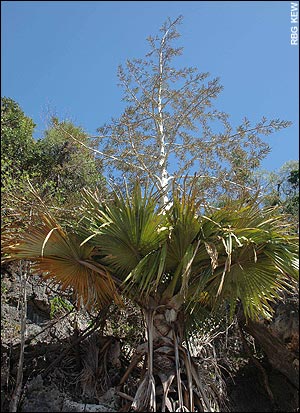New Monster Palm Discovered
Posted by: Loren Coleman on January 17th, 2008
New findings are everywhere, sometimes even when you happen to be on picnic!

The palm will be called Tahina spectabilis which is Malagasy for blessed or to be protected. Tahina is the name of one of the discoverer Xavier Metz’s daughters.
The most important new species of palm for 50 years has been discovered by a family picnicking in the jungle.
Tahina spectabilis soars 60ft (18m) as it puts out millions of flowers in a spectacular last hurrah that kills it. Despite its size it escaped detection until Xavier Metz, a plantation owner, took his family for a picnic in Madagascar.
Dr Bill Baker, of the Royal Botanic Gardens, Kew, said finding the plant was equivalent to a zoologist identifying a new species of elephant hidden in a jungle. “It’s the most astonishing new palm in the last 50 years,” he said. “It’s absolutely enormous.”
The palm lives for several years until growing a “candelabra” structure upon which millions of flowers appear. These drip with nectar, making the palm a magnet for birds and insects. The energy the palm has to put into reproduction depletes its reserves and it dies of self-inflicted exhaustion.
The palm is located in a small area of the west side of Madagascar rather than the wetter east where most of the island’s palms are found. It is thought that only a hundred exist.
The new species, whose name is announced in the Botanical Journal of the Linnean Society today, has leaves which, with a 16ft diameter, are among the largest seen in flowering plants.
John Dransfield, joint author of The Palms of Madagascar and an honorary research fellow of Kew, said that when he saw Mr Metz’s photographs of the tree, “I could hardly believe my eyes. I couldn’t wait to examine specimens in detail.”
Kew’s experts discovered that it was not just a new species but represented a genus never seen on Madagascar before. “It is very difficult to explain how it could ever have reached Madagascar,” Dr Dransfield added.Picnicking family stumbles on a suicidal monster palm tree, by Lewis Smith, The Times, January 17, 2008.
About Loren Coleman
Loren Coleman is one of the world’s leading cryptozoologists, some say “the” leading living cryptozoologist. Certainly, he is acknowledged as the current living American researcher and writer who has most popularized cryptozoology in the late 20th and early 21st centuries.
Starting his fieldwork and investigations in 1960, after traveling and trekking extensively in pursuit of cryptozoological mysteries, Coleman began writing to share his experiences in 1969. An honorary member of Ivan T. Sanderson’s Society for the Investigation of the Unexplained in the 1970s, Coleman has been bestowed with similar honorary memberships of the North Idaho College Cryptozoology Club in 1983, and in subsequent years, that of the British Columbia Scientific Cryptozoology Club, CryptoSafari International, and other international organizations. He was also a Life Member and Benefactor of the International Society of Cryptozoology (now-defunct).
Loren Coleman’s daily blog, as a member of the Cryptomundo Team, served as an ongoing avenue of communication for the ever-growing body of cryptozoo news from 2005 through 2013. He returned as an infrequent contributor beginning Halloween week of 2015.
Coleman is the founder in 2003, and current director of the International Cryptozoology Museum in Portland, Maine.










I want one for my back yard, just above the waterfall!
a botanical elephant!!
gotta love that phrase
kind of adds a little more hope to all the cryptids smaller then an elephant in the rest of the world
If gigantic stationary trees are still being discovered perhaps there is hope for some of our animal cryptids as well.
I’d love to see someone standing beside this tree for scale so I could get a good visual grasp of its size.
I was just reading about this elsewhere, and they said that it pretty much looks just like any of several other palm species for up to 100 years, until it sprouts this “candelabra” (The article I read called it a “Christmas tree”) which flowers, and then it dies. Personally, I think that’s pretty cool.
A thought follows this, however. If such a unique tree can go unnoticed for so long, looking completely normal to most everybody, then perhaps the more peculiar vegetable cryptids (At least one of which is rumoured to live on Madagascar, I believe) operate on a similar basis. Maybe that completely ordinary looking stump in India WAS a man-eating tree when it was in its active stage…
Kittenz, the article I read said it could grow to 66 feet in height with 16-foot-long leaves…
If flowering kills it, how are the seeds produced? Is this a male flower at the end of life, after having produced female flowers for years?
I’m not much of a botany guy, but this is still exciting news especially considering the size of this thing. The amount of biodiversity that is still out there to be found is stunning. Cool to see an article here about “cryptobotany”!
An amazing find. What with this and the new monkey found recently as well, 2008 is shaping up to be an excellent year already for new crypto discoveries! 🙂
Simply beautiful. What a great find. I should go picnicking more. I also recall an article from the archives on the cow-eating tree of Madagascar. Fascinating!
I want to believe that there really is such a tree out there.